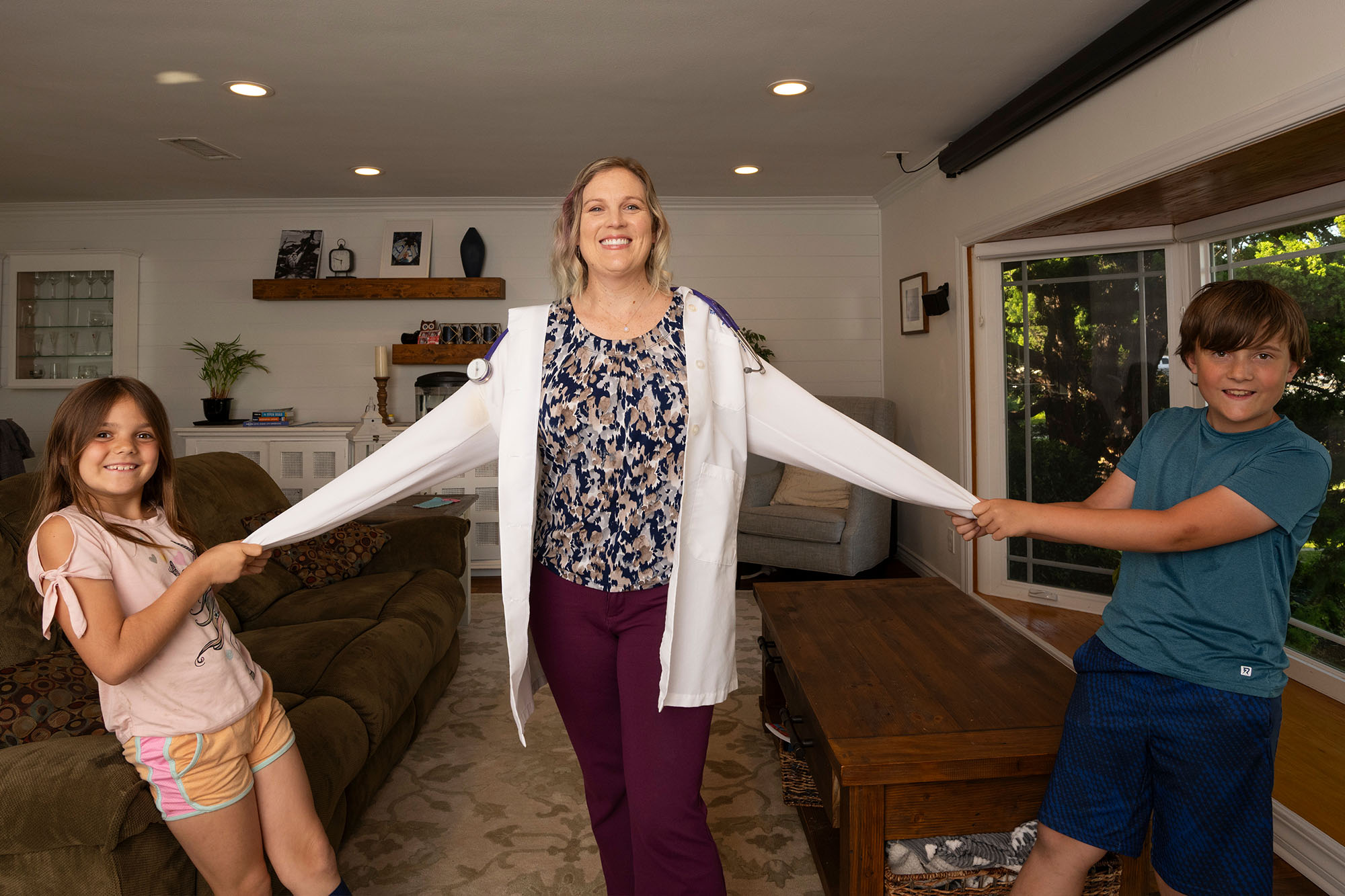|
Getting your Trinity Audio player ready…
|

Artificial intelligence (AI) is swiftly reshaping the health care landscape, but the impressive array of helpful new tools is not equally accessible to everyone. While private hospital systems and commercial insurance plans can afford technologies that could alleviate burdens on their workforce and improve patient care, California’s health care safety net is at risk of being left behind. It’s a problem that worries the people who run the medical and social service organizations that serve millions of Californians with low incomes.
If safety-net institutions miss out on the potential of AI, it could widen persistent racial and ethnic health disparities in that population, said Stella Tran, senior program investment officer at the CHCF Innovation Fund. “It would be a tale of two health systems,” she said.
The potential applications of AI are significant: Ambient note-taking technologies that could reduce burnout and give providers more face time with patients. Chatbots that could offer speedier access to care. Tools that could assist with diagnostics and help predict patient health outcomes. Many others are being developed as well.
CHCF wanted to learn more about spreading AI equitably, so it partnered with the California Health and Human Services Agency to listen to 45 safety-net leaders from across the state. In three focus group sessions conducted between August and October 2024, leaders of managed care plans, hospitals, community clinics, and community-based organizations offered their perspectives on AI. There was a strong desire to share their experiences and perceptions. “We had one clinic leader drive over three hours each way to be at the table,” said Katie Heidorn, CHCF’s director of state health policy.
Safety Net Access to AI
The lively strategic discussions, which offered confidentiality to encourage candor about sensitive issues, confirmed that safety-net organizations face restrictive barriers to the safe and effective adoption of AI. Those obstacles include prohibitive costs, workforce limitations, and concerns about liability.
Participants shared the capabilities of AI that excite them, offered use cases, and commiserated over challenges — especially the need for increased resources to help safety-net institutions rapidly adopt AI tools that could improve their services. Many said their organizations cannot afford to integrate new digital tools into their workflows. “The pricing models don’t work for the safety net,” said Kara Carter, CHCF’s senior vice president for strategy and programs. AI products that charge per usage or per provider visit are currently too expensive for safety-net organizations, she said, adding, “That’s going to have to change.”
Participants also explored group purchasing and other strategies to access AI products. One solution could be for vendors to offer discounts to safety-net organizations, perhaps by partnering with other AI companies to create bulk deals, said Heidorn.
But that method wouldn’t ease the infrastructure and personnel requirements, she said. Few safety-net organizations can afford to hire expert staff to oversee AI implementation.
Well-resourced hospital systems have large data management capacity, with large IT departments and data science staff at their disposal. “A community clinic may not have the data scientists on staff needed to implement AI,” said Tran.
Because safety-net organizations are already burdened by projects aimed at improving infrastructure and care delivery, the surge in AI technology is causing a sort of paralysis, participants said. Organizations may need to put AI adoption on the back burner because they are prioritizing the enhancement of other technical capabilities, such as data exchange.
Nimble Organizations Take More Risks
“Across the board, there are underlying problems in infrastructure,” Carter said. “But if we wait to move on AI until we fix all of those, we miss the boat.”
The sessions revealed that nimble organizations with simpler structures and decisionmaking pathways feel freer to take risks with AI, such as a small community health worker organization that created its own generative AI tools because commercial options didn’t suit their specific needs.
Providers say they often hesitate to purchase AI tools because the financial benefits are unclear. “We need to find examples of return on investment and share them widely to make the case for AI really clear,” Tran said.
Ambient scribing improves physicians’ quality of life by reducing the time needed to write patient notes after hours. Hospitals and health systems, however, assign less value to savings generated by physicians who were volunteering their time anyway. Yet when the tool is framed as a way to bolster employee retention, other cost savings become clearer. “What is the cost of losing the doctor? Or of hiring a new provider?” Tran said. Taken further, employee retention yields savings by ensuring that patients can be seen in a timely fashion, and therefore possibly avoid developing more complex conditions that are expensive to treat.
Examining returns on investment this way reflects lessons learned from mistakes of the past, CHCF leaders said, pointing to missed opportunities when electronic health record (EHR) systems were introduced two decades ago. That process resulted in discrepancies in the implementation of EHRs in well-resourced versus safety-net systems. “It was fragmented, and it wasn’t made for effective data exchange,” said Carter. “Those mistakes have been really expensive to fix.”
The listening tour showed that safety-net organizations already see the AI revolution as an opportunity to do things differently, Carter said. “I was thrilled to hear that sentiment from participants,” she said.
Top Worries About AI in the Safety Net
But as eager as they are to seize AI opportunities, several concerns about access and equity remain top of mind.
First and foremost, safety-net providers are worried about who bears the financial risk for AI errors. They said the state should establish accountability guidelines showing which parties are responsible for the safety of the technology. “They’re concerned about risk if it messes up,” said Heidorn.
The path of least resistance may be to put the onus on health organizations rather than on AI developers because health care providers are already accustomed to being heavily regulated, Heidorn said. But that might create a chilling effect in which safety-net organizations avoid AI out of liability fears, she said.
On the other hand, laying too much financial risk on developers might deter innovators from tackling safety-net problems. Some form of safe harbor for providers and developers alike may be the sensible path forward, Carter said. “Organizations want to be able to try and fail, and that is hard to do without clear accountability,” she added.
Safety-net organizations need to be included in data exchange networks, and their patient data should be used to train AI models to counter racial and ethnic biases, Carter said. Small clinics need to have access to the same large data resources that well-resourced systems have, and AI innovators need to ensure that their technologies prioritize primary care. “We can’t be leaving out the part of the infrastructure that safety-net patients interact with the most,” Carter said.
Likewise, attention needs to be directed to ensuring that certain regions and populations aren’t left out of these digital advances. The Central Valley and rural Northern California, for instance, suffer from poor broadband connectivity, affecting organizations’ abilities to implement new AI technologies. Participants from Southern California emphasized the challenges of sharing data between Los Angeles County’s many systems, while those from the Central Valley spoke of the need for data exchange programs that can follow the movements of farmworkers. And regions with sizable immigrant populations are concerned about the technologies reaching those who speak languages other than English. Designing AI tools that can address these barriers will help to shrink health care’s existing digital divide.
Extensive Dialogue Needed
Crafting new policies will require extensive dialogue among lawmakers, safety-net providers, and AI developers. “There are information gaps on all sides,” Heidorn said. “We need to ensure that lawmakers are educated in AI, and that the AI learnings specific to health care are passed on to the state.”
So far only health care leaders and providers have had input on AI, so CHCF plans to host listening sessions with safety-net patients to understand their perspectives, said Heidorn. That will help policymakers, developers, and safety-net leaders ensure that the deployment of AI is tethered to the future of health equity. Already, Medicaid enrollees have worse health outcomes than those with commercial coverage — and if Medicaid patients are unable to reap the same benefits of AI tools as commercial health systems, those disparities will worsen. What’s more, in the face of workforce shortages, primary care deserts, and other critical health care problems facing the state, AI could help the Californians with lower incomes edge closer to having equitable access to care.
The safety net needs to be given a seat at the table, CHCF leaders said. “AI can address long-standing issues in our delivery system,” said Tran, “and we want to make sure our corner of the world has access to that.”
Authors & Contributors

Robin Buller
Robin Buller is an Oakland-based writer, researcher, and editor. She has reported on harm reduction, maternal health, migration, housing, and policing for The Guardian, The Oaklandside, and other publications.
Originally from Canada, she holds a doctorate in history from UNC Chapel Hill and has lived in California since 2018.

Jessica Brandi Lifland
Jessica Brandi Lifland is a freelance photographer, instructor of journalism at City College of San Francisco, and mother. Her work with publications and nonprofits such as Operation Smile, Tostan, and the California Health Care Foundation has taken her all over the world, including West Africa, the Middle East, Kosovo, Burma, Haiti, and South America.
For two decades she has been photographing the National Cowboy Poetry Gathering and has been working on a long-term project documenting the lives of the cowboy poets of the American West in affiliation with the Western Folklife Center. She plans to make her project into a book.



